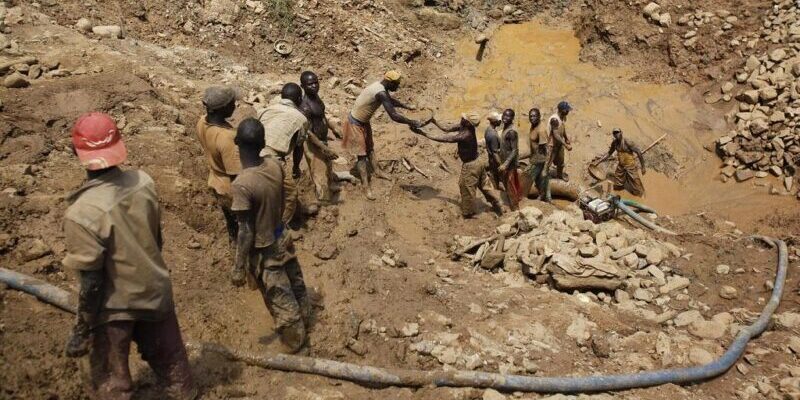Artisanal mining to help sustain global markets
Formalising artisanal mining has become a challenge that most mining industries are facing today especially those that in remote areas.
Many organisations have since stepped in to help curb the situation.
The organisations are focusing on making artisanal and small- scale mining (ASM) safer and more productive, since it is here to stay and is sustaining many communities, particularly in African areas that have the most mining operations.
Speaking during the June 9th Webinar about formalising the ASM in the Democratic Republic of the Congo(DRC) in the lead-up to the DRC mining week conference which is set to be hosted from the October 7 to 9, should Covid-19 restrictions permit.
The experts on the webinar agree that ASM accounts for about 20% of metal production globally and, therefore, will continue to play an important role in the supply chain. More responsible practices need to be developed.
Commodity trading company Trafigura corporate responsibility head James Nicholson says the company aims to advance trade responsibly, which means responsible sourcing is essential.
“Responsible sourcing involves considering risks to people and to the environment, it is very difficult to operate in practices and also to help develop supply chains,”Nicholson said.
He also mentions of the two-thirds of global cobalt production which comes from the DRC, with ASM accounting for between 20% and 40% of this production.
“Artisanal mining is considered to be a very tough and often dangerous occupation, but it is a fact of life in many developing countries. Some have decided to exclude and even publicly undermine artisanal mining production, but we believe this is illogical and counter-productive,” he added.
He also stated that the market has never been more aware of the contribution that the ASM industry has to the mining sectors and trade. However, market requirements are changing, for example with financing becoming more focused on “clean” projects, metal exchanges enforcing mandatory due diligence, and consumer and investor awareness around risks, responsibility of source and impact of operations becoming more evident.
Trafigura has helped to transform ASM mining sites to safer and more productive operations in the DRC, by, working with local implementing partners and stakeholders to fence sites and implement access controls, make safety inspections and personal protective equipment mandatory, and not permitting deep pits and tunnels to be mined.
Non-profit international development organisation PACT Mines to Markets Great Lakes Region technical manager Stephanie Shumsky points out that ASM produces between 15% to 25% of all gold, 80% of all coloured gemstones, 50% of all tantalum, at least 30% of all tin and 25% of all mica.
She believes ASM miners are the world’s hidden suppliers.
PACT works with governments, industry and miners themselves to make ASM formal, safer and more productive.
US Agency for International Development implementing partner company Global Communities DRC country director Lazarre Potier says the organisation aims to establish a commercially-viable conflict-free ASM gold supply chain originating from the eastern DRC.
Global Communities is currently piloting a variety of responsible supply chain models in the country to see what will work in the country. The organisation is looking at how to address the legalities related to ASM mining and the trade and export of these minerals.
The organisation is profiling miners and engaging with downstream players around their concerns to build due diligence processes.
“There are a number of ways in which the market can be stimulated to get the attention of downstream players to engage in the DRC and we are helping to address the most pressing challenges.
“Some of these ASM sites can be best realised for value when they are scaled, but others can be linked with larger commercial operations in the area. We keep in mind the best fit and context of projects in the country,” says Potier.
Further, commodity research company CRU Group lithium, cobalt and battery markets senior analyst George Heppel notes that there is great difficulty in reporting ASM output, since it is often individual miners who sell to local cooperatives, local merchants and traders, or ship product to China.
Heppel explains that, traditionally, most artisanal cobalt ore in the DRC was shipped directly to China, making it easier to track through trade statistics, but since 2016 most artisanal ore is blended and processed into cobalt hydroxide in the DRC, making it harder to track and audit supply chains.
He points out that artisanal supply made up around 10% of global supply of cobalt in 2019.
Heppel states that ASM mining balances the cobalt market in times of shortage.
“In times of cobalt shortage, ASM is vital in keeping the world well-supplied with units for industry. The world would have been in a gigantic deficit had ASM not increased in 2018.
“Artisanal miners are also able to react to prices much quicker than mining companies.”
Heppel further points out that the ASM industry has evolved to processing in-country over the last few years, compared with exports of concentrate previously.
“This has made it more important than ever to have traceability within the supply chain, especially considering that ASM will never go away,” he concludes.
Artisanal mining in the DRC employs as many as 200 000 people.





